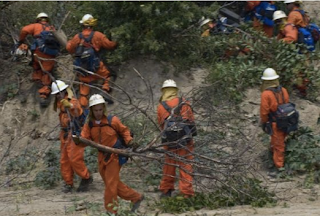On June 7th, Richard Ramirez, otherwise known as the Night Stalker, became the 85th inmate to die of natural causes while on San Quentin’s Death Row. Many Californians still remember his string of heinous crimes committed in Southern California and beyond in the 1980s. A disturbed teen turned serial killer, Ramirez brutally murdered and abused many innocent people, mutilating the bodies, and expressing no remorse for his horrific deeds. If there ever were anyone deserving of the death penalty, it would be Ramirez.
Like his 84 predecessors, Ramirez maximized the usage of his appellate rights. He was still litigating well into the late 2000s, and his numerous appeals were exhausted only a short while before a DNA match linked him to yet one more brutal murder from the 1980s.
Regardless of one’s ideological stance on capital punishment, Ramirez’s death is a sad illustration of the extent to which the death penalty in California is stuck in limbo and broken beyond repair. The litigation efforts in recent years have not focused on the grand questions of the morality of state-sanctioned executions, racial discrimination and deterrence. Instead, courts have, for years, “tinkered with the machinery of death”, and litigation has focused on increasingly technical minutiae of execution protocols, such as the availability and effect of different chemicals used in executions.
The latest installment in death penalty litigation is a case in point. Earlier this week, the 1st District Court of Appeals affirmed a Marin court decision that effectively put the death penalty in California on hold again. The reason: The California Department of Corrections and Rehabilitation (CDCR) did not satisfy the administrative requirements to properly notify the public of various aspects of its recently amended three-drug protocol. The Supreme Court’s ruling in Baze v. Rees (2008) established that three-drug executions did not violate the Eighth Amendment, but CDCR’s protocols preceded the decision and therefore could not rely on it. In the decision, Justice Anthony Kline wrote that the information CDCR provided to the public exhibited numerous inaccuracies and did not include proper discussion of alternatives to the three-drug method or of the protocol’s costs.
While the public certainly needs to be informed of how its tax dollars are spent in the correctional arena, one cannot read the decision without thinking whether our conversation about the death penalty shouldn’t be deeper and more substantive. Searching for a humane method for putting people to death is, by definition, a fairly futile effort, and incessant discussions of this nature, which have become, by necessity, the bread and butter of death penalty litigation, are missing the bigger picture. Capital punishment lawyers and judges may have no choice but to pore over these technical details, but we, as a society of voters and policy makers, owe ourselves and our fellow Californians a better conversation.
Proponents of the death penalty may bemoan the days in which the condemned were summarily executed in the town square without appeals, habeas proceedings, or quibbling over drug protocols. But those days are over, and given the current political climate in the state, they will probably not return; a recent effort by the California District Attorneys’ Association to push for simplified capital litigation with less post-conviction relief has failed. What we know about the incidence of wrongful convictions is a frightening warning sign to anyone who might want to turn time backwards and streamline the execution process. Experts estimate that up to 5 percent of all convictions may be wrongful, and the prospect of an irreversible punishment should be disturbing to anyone who cares about justice, regardless of political affiliation.
Since the lengthy and expensive appellate process is here to stay, it is time for Californians to ask themselves the same good questions that the people of New Mexico, Illinois, Connecticut, Maryland, New York and New Jersey have asked themselves since the onset of the financial crisis: Are the benefits of the death penalty, in terms of retribution and deterrence, worth the hassle and expense?
One such good question might be how the families of Ramirez’s numerous victims feel in the wake of his natural death. For some, an execution might have brought closure and relief; others perhaps would consider the thirty-year wait to no avail an excruciating ordeal and a waste of state resources. A recent study of California violent crime victims, conducted by Californians for Safety and Justice, confirms the solid research according to which crime victims are not more punitive than non-victims. The study, albeit limited by response rates, found low-income people and people of color to be disproportionately represented in the victim group. Victims surveyed in the study tended to view incarceration as futile and to prefer investment in rehabilitation and drug programs. It well may be that some victims are underserved by waiting for a cathartic event that may or may never happen, and that the interminable wait (necessitated by the concern over wrongful convictions) does some families more harm than good.
Another such good question would be whether our legitimate desire for retribution–especially justified in cases like Ramirez’s–is making us confuse fact with fantasy. Perhaps the death penalty as some would want it to be would provide proper retribution; the death penalty as administered in California today does not.
And finally, the question of effective deterrence via capital punishment, which was at the forefront of the conversation in the mid-1970s, has been relegated to the provenance of small handful of economists still studying it. The American Law Institute withdrew its support of the death penalty in 2010, finding no strong evidence for deterrence, and a 2012 report from the National Research council concluded that “research to date on the effect of capital punishment on homicide rates is not useful in determining whether the death penalty increases, decreases, or has no effect on these rates.” Unfortunately, violent crime will probably never completely disappear, and people like Ramirez will again perpetuate unspeakable crimes. Whether they do so despite, or because, of capital punishment or its absence is, and will always, remain unclear.
Our hearts weep for the many victims of Ramirez’s cruelty, and that of other perpetrators of vicious crimes. Let us punish these people properly, soundly, and economically, by sentencing them to life without parole, and give up on the hollow hopes of a death penalty that is anything but.





